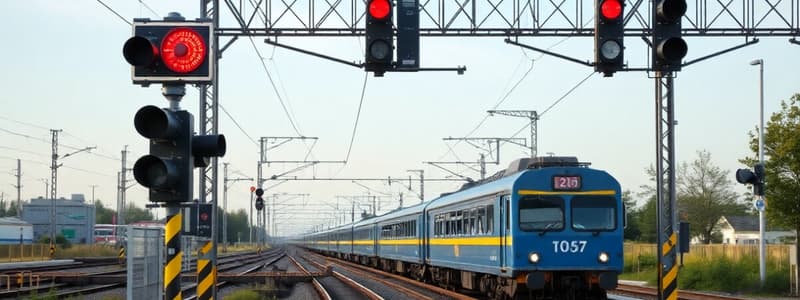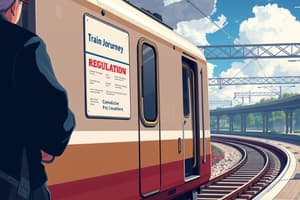Podcast
Questions and Answers
What does the 'Train On Line' feature ensure in non-co-operative type instruments?
What does the 'Train On Line' feature ensure in non-co-operative type instruments?
- The instruments alert the sending station when a train departs.
- The instruments remain in a 'Line Closed' position.
- The instruments can be manually adjusted at all times.
- The instruments automatically set to 'Train On Line' when a train enters the block section. (correct)
What functionality does the Audible Indicator provide in the block section?
What functionality does the Audible Indicator provide in the block section?
- It indicates when shunting operations are allowed.
- It provides visual warnings for incoming trains.
- It signals the end of a block section.
- It alerts the receiving station when the train enters the block section. (correct)
What is a requirement for track circuits or axle counters used to prove block section clearance?
What is a requirement for track circuits or axle counters used to prove block section clearance?
- They only need to monitor the last stop signal.
- They must extend from the entrance to the exit of the block section. (correct)
- They can be powered by external energy sources.
- They do not require maintenance after installation.
What must be included in shunting keys for non-co-operative type instruments?
What must be included in shunting keys for non-co-operative type instruments?
Why is the Last Stop Signal of the block station automatically replaced to 'ON'?
Why is the Last Stop Signal of the block station automatically replaced to 'ON'?
What type of block instruments is permitted for use in a 25 KV electrified line?
What type of block instruments is permitted for use in a 25 KV electrified line?
What is the maximum length of parallelism for using a push button type block instrument on a non-electrified section?
What is the maximum length of parallelism for using a push button type block instrument on a non-electrified section?
Which of the following block instruments requires prior approval from the Railway Board for use?
Which of the following block instruments requires prior approval from the Railway Board for use?
What feature ensures that opposing Last Stop Signals in a single line cannot be taken 'OFF' simultaneously?
What feature ensures that opposing Last Stop Signals in a single line cannot be taken 'OFF' simultaneously?
Which of the following block instruments is being phased out?
Which of the following block instruments is being phased out?
Which type of communication cable is specifically mentioned for block instrument operation?
Which type of communication cable is specifically mentioned for block instrument operation?
In block instrument setups where Optical Fiber Cable (OFC) is used, what must also be utilized?
In block instrument setups where Optical Fiber Cable (OFC) is used, what must also be utilized?
What type of device is required to absorb surges in the protective device arrangement?
What type of device is required to absorb surges in the protective device arrangement?
Which component is not supposed to be powered by the battery used for each block instrument?
Which component is not supposed to be powered by the battery used for each block instrument?
What is the purpose of the transformer when quad cable is used for block instruments?
What is the purpose of the transformer when quad cable is used for block instruments?
Which feature is essential in the configuration when the distance between UFSBI and the block instrument exceeds 500 meters?
Which feature is essential in the configuration when the distance between UFSBI and the block instrument exceeds 500 meters?
What is the preferred method for terminating insulated line wires?
What is the preferred method for terminating insulated line wires?
Which of the following is a requirement for indoor wires?
Which of the following is a requirement for indoor wires?
What is mentioned regarding radio or optical fiber cables?
What is mentioned regarding radio or optical fiber cables?
What must be ensured regarding induced voltage due to power line parallelism?
What must be ensured regarding induced voltage due to power line parallelism?
How should line wires be positioned when leading to the building?
How should line wires be positioned when leading to the building?
What is a key feature for the provision of cables used in instrument circuits?
What is a key feature for the provision of cables used in instrument circuits?
What is the maximum short circuit fault current allowed due to power line parallelism?
What is the maximum short circuit fault current allowed due to power line parallelism?
Where should lightning dischargers be installed in relation to block instruments?
Where should lightning dischargers be installed in relation to block instruments?
What is required for the protective earth connection of SPDs for Block instruments?
What is required for the protective earth connection of SPDs for Block instruments?
In a single line token block instrument, when is the slow release relay energized?
In a single line token block instrument, when is the slow release relay energized?
What is the purpose of using metallic return in block circuits?
What is the purpose of using metallic return in block circuits?
What is required for the battery voltage in a double line block instrument?
What is required for the battery voltage in a double line block instrument?
What is one requirement for all block instruments according to installation standards?
What is one requirement for all block instruments according to installation standards?
What is specifically mentioned about turn-table arrangements for token and handle type instruments?
What is specifically mentioned about turn-table arrangements for token and handle type instruments?
What characteristic do bell units or buzzers need to have when multiple block instruments are in the same room?
What characteristic do bell units or buzzers need to have when multiple block instruments are in the same room?
What should be provided across the Galvo in the modified filter circuit?
What should be provided across the Galvo in the modified filter circuit?
Flashcards
Automatic Train On Line
Automatic Train On Line
A system that automatically sets instruments to 'Train On Line' when a train enters a block section and maintains it until the train passes the receiving Home Signal.
Audible Indicator
Audible Indicator
A warning sound to the receiving station when a train enters a block section at the sending station.
Shunting Keys
Shunting Keys
Two keys used for shunting authority in a block section, one for each line.
Track Circuits/Axle Counters
Track Circuits/Axle Counters
Signup and view all the flashcards
Block Section Indicator
Block Section Indicator
Signup and view all the flashcards
Last Stop Signal
Last Stop Signal
Signup and view all the flashcards
First Stop Signal
First Stop Signal
Signup and view all the flashcards
Single Line Token Instrument (Neal's)
Single Line Token Instrument (Neal's)
Signup and view all the flashcards
Non-electrified Section Push Button Block
Non-electrified Section Push Button Block
Signup and view all the flashcards
Double Line Block Instrument (SGE)
Double Line Block Instrument (SGE)
Signup and view all the flashcards
Axle Counter Block working
Axle Counter Block working
Signup and view all the flashcards
Block Proving by Axle Counter
Block Proving by Axle Counter
Signup and view all the flashcards
Direct Block Working from EI
Direct Block Working from EI
Signup and view all the flashcards
Special PVC Insulated Quads
Special PVC Insulated Quads
Signup and view all the flashcards
Universal Fail-Safe Block Interface (UFSBI)
Universal Fail-Safe Block Interface (UFSBI)
Signup and view all the flashcards
Protective Devices (Chokes & Condenser)
Protective Devices (Chokes & Condenser)
Signup and view all the flashcards
SPD earth connection
SPD earth connection
Signup and view all the flashcards
Single Line Token Block Instrument (RE Area)
Single Line Token Block Instrument (RE Area)
Signup and view all the flashcards
Stray DC in Block Circuit
Stray DC in Block Circuit
Signup and view all the flashcards
Modified Filter Circuit
Modified Filter Circuit
Signup and view all the flashcards
Double Line Block Instrument (RE Area)
Double Line Block Instrument (RE Area)
Signup and view all the flashcards
Battery Voltage Requirement
Battery Voltage Requirement
Signup and view all the flashcards
Block Instrument Fixture
Block Instrument Fixture
Signup and view all the flashcards
Distinctive Bell Units
Distinctive Bell Units
Signup and view all the flashcards
Line Wires
Line Wires
Signup and view all the flashcards
Pot-head Insulators
Pot-head Insulators
Signup and view all the flashcards
What's the purpose of a drip loop?
What's the purpose of a drip loop?
Signup and view all the flashcards
Indoor Wires
Indoor Wires
Signup and view all the flashcards
Leading-in Wires
Leading-in Wires
Signup and view all the flashcards
Why are lightning dischargers installed separately?
Why are lightning dischargers installed separately?
Signup and view all the flashcards
What limits do power lines impose on block instruments?
What limits do power lines impose on block instruments?
Signup and view all the flashcards
Why is a separate cable needed for each block instrument circuit?
Why is a separate cable needed for each block instrument circuit?
Signup and view all the flashcards
Study Notes
Non-Cooperative Type Instruments
- Requirements from paragraph 18.1.5 apply
- Automatic "Train On Line" sets the instrument to "Train On Line" when a train enters a block section, maintaining this status until the train passes the home signal and the instrument is set to "Line Closed"
- Audible indicator warns the receiving station when a train enters the block section
- Two shunting keys, one per line, are interlocked with the block instruments, granting authority for shunting within the block section
Train Detection for Proving Block Section to be Clear
- Track circuits or axle counters extend from the last stop signal to the first stop signal within a block section
- An indicator in each block station displays whether the block section is occupied
- A control ensures the last stop signal automatically switches to "ON" upon a train's passage and remains "ON" until the train clears
- A control ensures the first stop signal automatically switches to "ON" upon a train's passage
Block Working in RE Area
- Specific block instruments are required for 25KV electrified lines
- Single Line Token Instrument (Neal's)
- Single Line Token Instrument (Handle Type - Daido)
- Block working with Axle Counter
- Block Proving by Axle Counter
- Block working directly from El
- Neal's token instruments are being phased out
- Push-button instruments may be used in non-electrified sections (max 1.5 km) connected to electrified sections
Media
- Block instruments may use special PVC-insulated quads in aluminum-sheathed cable or other communication methods like optical fiber and radio
- Quad cable usage requires transformers to work block telephone and block bell circuits through phantom pairs
- Optical Fiber/Radio usage requires a Universal Fail Safe Block Interface in a relay room, and a block panel in the ASM room
Protective Devices (Others)
- Two chokes in series with a four-terminal condenser and a surge arrester are required; their illustration is provided in Drawing 18-D4 to protect against surges in faulty conditions
- Each block instrument uses separate battery or DC-DC converter
- Separate earths are provided for Signal Protection Devices (SPDs) and Block and connected to the common ring earth of the indoor signalling system
Single Line Token Block Instrument in RE Area
- Earth return usage substitutes the instrument's rest contact with a slow-release relay
- Metallic return for block circuits is required if stray DC is present in the earth
- Modified filter circuit is used in place of a condenser
Double Line Block Instrument in RE Area
- IRS type block instruments with block filters are used for 25KV AC-electrified sections and circuit details are provided in drawing 18-D7
- Battery voltage must sufficiently provide 18–25mA current for the polarized relay
General Fixture for Block Instruments
- All block instruments must be of approved type
- Block instruments are securely fixed to the table/fixture
- Tables or fixtures must be substantial enough to support instruments
- Turn-table fixtures may be provided to assist with maintenance
- Block instruments should have distinct bell units/buzzers in the same room
Transmission Media and Wiring
- Line wires connecting adjacent block sections are either insulated or positioned at least 150 mm from other wires; insulated wires are preferred
- Line wires are terminated on pothead insulators
- Wires are led in an upward direction or drip loops are provided for wire routing to the building
- Indoor wires use troughs or trunking for separation from other circuits; a separate cable for each instrument circuit is recommended; braided or metal sheathed cables are suitable
- Alternative cable method used with suitable protection for better protection
- Radio/Optical fiber cable use requires approved type block interface (use in lieu of line wires)
Studying That Suits You
Use AI to generate personalized quizzes and flashcards to suit your learning preferences.




